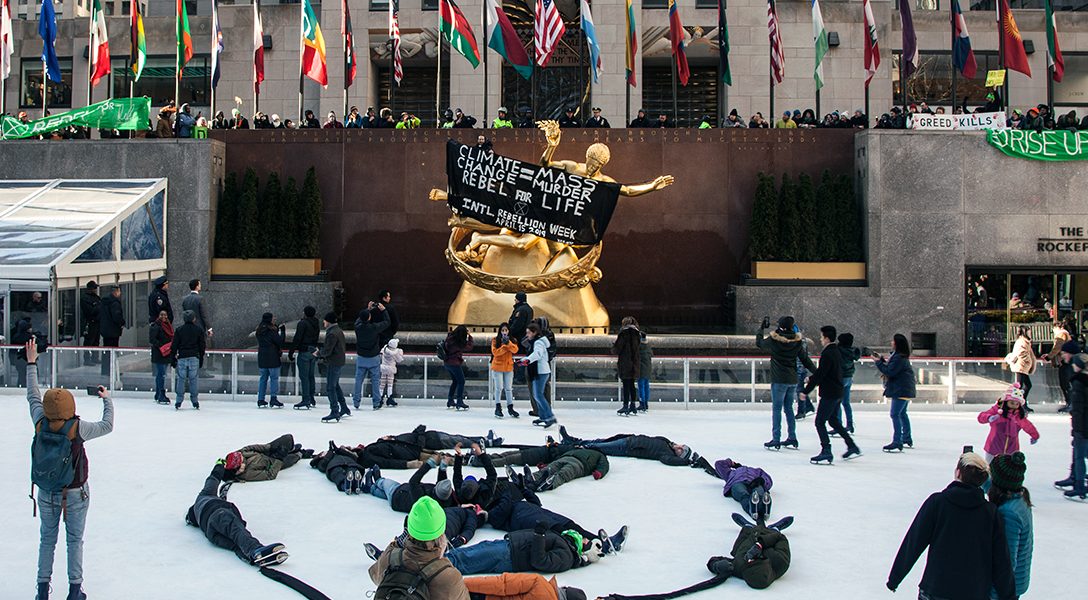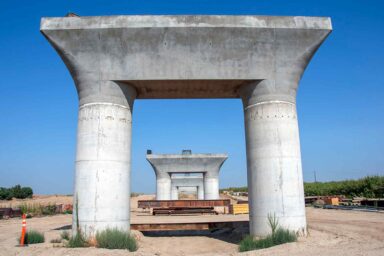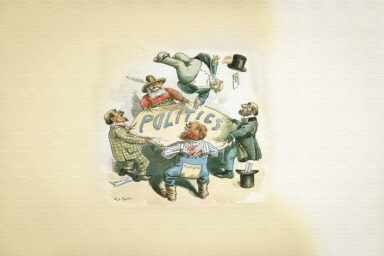A new organization seeks to take on ‘climate breakdown’ and global capitalism through direct, nonviolent action.
No matter how unseasonably cold or hot it gets or how powerful the storms are, there will be those who still don’t accept the urgency of climate change. For the rest of us, who believe we humans are destroying life as know it on earth, the group Extinction Rebellion (XR) has a message: We must change our behavior now, or die.
In this week’s WhoWhatWhy podcast, Rory Varrato, a US spokesperson for the group, explains that XR was formed last fall amid one of the the biggest acts of peaceful civil disobedience in the UK in decades. He notes that, unlike other climate-change activist groups, XR seeks not just to bring attention to the issue but to force action on several non-negotiable demands.
At the top of the list, according to Varrato, are: 1) getting government, corporations, and the media to address the emergency of global climate change head-on; 2) bringing about nothing short of net-zero carbon output by 2025; and 3) reorganizing society to include direct democracy, citizen assemblies, and “climate justice.”
Varrato takes direct aim at global capitalism as we know it. He lays out a radical agenda that includes a slower, more sustainable way of life for all and a more local approach to even the most complex issues.
While acknowledging that there is not always a straight line between policy reform and civil disobedience, he and his colleagues see the latter as a starting point.
Click HERE to Download Mp3
Full Text Transcript:
As a service to our readers, we provide transcripts with our podcasts. We try to ensure that these transcripts do not include errors. However, due to time constraints, we are not always able to proofread them as closely as we would like. Should you spot any errors, we’d be grateful if you would notify us.
| Jeff Schechtman: | Welcome to Radio WhoWhatWhy, I’m Jeff Schechtman.
Amidst the cacophony of Russian collusion, Venezuela, a wall, and healthcare, we don’t always appropriately triage our greatest national security threat, the very real and existential threat of climate change. That’s why some feel it’s important to go to extremes to call attention to the issue and the dangers. This past weekend in New York witnessed the first national day of action for a new group called Extinction Rebellion, a grassroots social movement that began in the UK last fall and has now come to America. |
| One of its organizers is our guest today on the WhoWhatWhy Podcast. He is Rory Varrato. He’s a student in the Philosophy and Education Program at Teachers College, Columbia University, and currently serves on the media and messaging working group for the New York City chapter of Extinction Rebellion. It is my pleasure to welcome Rory Varrato here. Rory, thanks so much for joining us. | |
| Rory Varrato: | Oh, thank you a lot for having me. |
| Jeff Schechtman: | Tell us about Extinction Rebellion, how did it get started originally in the UK last fall and a little bit about its history and some of the organizers? |
| Rory Varrato: | Sure. As you alluded to, the origins of the movement are in the UK and a little bit of that is shrouded in mystery to those of us who are involved in the organization, but I can tell you that in late October there were open letters issued that were signed by many prominent academics including Noam Chomsky, Bill McKibben, Naomi Klein, and some politicians as well. And they framed climate breakdown in very, I would say, dire but realistic terms and advocated for the kinds of direct action that Extinction Rebellion would then go on to take. |
| So shortly afterward, November 17th, I believe, Extinction Rebellion took major action in London, shutting down five bridges over the Thames, and this got international attention and was sort of like a signal flare going up for other like-minded folks around the world. So that action, that initial action inspired the opening of chapters of Extinction Rebellion globally, in small towns and large cities alike. And here in New York City, we’ve been only in existence since early December, and in that time we’ve grown rapidly and managed to plan this major action that we conducted in midtown this past Saturday. | |
| Jeff Schechtman: | Talk a little bit about the goal of these direct actions. What do you hope to accomplish by these events, the event in London being, of course, the most notorious, but similar events that are taking place around the world? |
| Rory Varrato: | Sure. I think there are multiple goals. And one of them, probably the most significant, is to communicate. Civil disobedience is an act of political communication. So Extinction Rebellion engages in direct action, nonviolent direct action and disruption for the purpose of communicating a message. And that message is precisely that climate breakdown is much more dangerous and threatening than is recognized in most of the mainstream media. And of course there are many climate change deniers like the President himself. And that’s a whole different sort of problem. |
| But the direct actions are intended to bring attention to this fact and to sort of shake people out of their apathy and their sleep about this matter, because really our only hope is through coordinated collective action. The government, governments I should say, around the world are not only not doing enough, as we saw with, for example, Trump’s unilateral withdrawal from the Paris Accords, which themselves were inadequate to address the problems, but they are actively exacerbating climate breakdown through allowing the expansion of activities like fracking. And now another example might be with the ascendancy of Bolsonaro in Brasil, the Amazon is under immediate threat. So Extinction Rebellion takes the view that it is genuinely up to the people, broadly construed, to form a grassroots democratic movement that can basically work to sustain life, including human life, on Earth, given the crazy circumstances that are already here and on the way. | |
| Jeff Schechtman: | Given the nature of direct action, how do you see that and how does the organization see it as a way to translate that into political action? Certainly it calls attention to the issue and arguably it calls attention among those people that are already believers in the cause. How does it translate into political action, particularly among those that might be on the fence or don’t realize the urgency of the problem? |
| Rory Varrato: | Great question. I think one way that it can translate is through the form of applying pressure. And also just sort of making politicians aware of the fact that not only is there a demand for these kinds of changes, but the demand is a strong demand. It’s a demand that has really the threat of action behind it. So for example, following the shutdown of the bridges in London, shortly afterward the mayor of London declared a climate emergency in that city. Those are the kinds of responses that we’re hoping to get from people as a result of our actions. |
| And I think there’s never a clear or straight line between civil disobedience and public policy change. I think it’s necessarily messy because civil disobedience, by its nature, takes place outside of the accepted and conventional channels for political action. But by raising awareness and by generating a clear demand or clear demands, politicians eventually feel that pressure and respond accordingly. | |
| Jeff Schechtman: | Given all the other noise and chatter that exists in the political landscape today, talk about how much harder it is to call attention to something like climate change. |
| Rory Varrato: | Yeah, it’s very difficult. Not only is there an enormous amount of chatter, as you say, but there’s also active dis- and mis-information campaigns and propaganda around climate change, climate breakdown. So we’re up against, for example, Exxon Mobile and other stakeholders in the fossil fuel industry that have real incentives for minimizing and neutralizing any anti-fossil fuel message. That’s part of the reason and that’s why civil disobedience is the centerpiece of Extinction Rebellion’s movement. It’s because here is some form of activity that can cut through that noise and those misinformation campaigns and receive some attention. |
| But it’s still challenging, then, to bridge, build a bridge of communication between a draft that can be a disruptive act of public civil disobedience, which many people will be inclined by their own biases to ignore or dismiss. It’s difficult to build that bridge between those actions and between a more elaborate and detailed plan of action. But I think to its credit, and part of what attracted me to the movement, is that Extinction Rebellion articulates its demands up front. So it’s rooted in demands, in other words, and we’re still developing and working on those and expanding those. But in contrast to, say, the Occupy Wall Street movement, for example, which struggled to articulate its demands at times, although great things came out of Occupy, like the language of the 1% and the 99%, etc. | |
| Extinction Rebellion from the get-go says here are our demands, here’s what we are about, and we’re performing these actions in this way to produce these results. | |
| Jeff Schechtman: | Is there a danger that civil disobedience, particularly around this issue and because of the nature of the debate on the issue, will work against bringing in some of the people that most need to be made aware of and politically engaged in something like this? |
| Rory Varrato: | Yes, I think they think that is a possibility. So we have to engage or employ a diversity of tactics, but we also have to be firmly committed to our core and central message and purpose. Yes, we will deter or dissuade some people, probably, through some of our actions. But if we’re operating in good faith and we believe in what we’re doing and we do it nonviolently, peacefully, etc, the hope is that we can disarm some people who may be inclined to ignore us or to even get angry at us and get them to just listen. In large part, Extinction Rebellion is about getting folks to pause and listen and question their beliefs and also to interrogate what exactly it is that Extinction Rebellion is doing and why. And speaking for myself, I would say that given the urgency, given the fact that we need to act immediately, there’s a sense in which we shouldn’t worry too much about not reaching, say, climate change deniers. We need to reach, at least at first, folks who are most receptive to our message and build outward from there because I think the key is not convincing people that climate change is real, many people do believe that even though there are large number of deniers in the United States, for example, but rather shifting the narrative towards this understanding that climate change is a problem now, for us today, and yesterday. |
| There is a tendency, especially in the mainstream media, to kick the can down the road. You will often see the date 2100, for example, in mainstream reporting on climate breakdown. And conveniently, that’s when all the worst problems will arise, when everybody alive today is dead, basically. And that’s part of the denial and the propaganda that’s baked into the discourse, the mainstream discourse about climate breakdown. So shifting the needle or the Overton window, really, towards a more reality-based view of climate breakdown is part of Extinction Rebellion’s goals. And I think the way that we do that is by reaching the people who are closest to that realization. | |
| Jeff Schechtman: | Beyond awareness, is there a specific public policy agenda that is part of the Extinction Rebellion effort? |
| Rory Varrato: | Yes. There are three core demands and we’re working on expanding and establishing others and building out the details of these demands. But I can tell you that the first demand is basically what I was just saying. The first demand is that governments and corporations and the media speak honestly and truthfully about the empirical reality of climate breakdown. This is important so that we can actually have an understanding of the situation and engage in appropriate and adequate responses to the situation. And this is something that we practice ourselves, familiarizing ourselves with the science and learning how to communicate most effectively about climate breakdown. Because quite frankly, if it were the case that we simply needed to list facts or statistics, then Al Gore, for example, would have saved the world ten or fifteen years ago when he released that documentary. It’s more than just listing facts. It’s more than just the science. So communicating about that is important. |
| That’s the first demand. The second demand goes more to your question, I think, which is a demand that fossil fuel, or rather, carbon emissions be reduced to net zero by 2025. This is … it’s extreme, but it’s not that much more extreme than the Green New Deal, for example, that was proposed, I think, by Jill Stein during her Green Party campaign and then picked up by Alexandria Ocasio-Cortez recently. So there are ways for us to do that, piggybacking off of those policy measures and expanding with some of our own. | |
| Rory Varrato: | Then the third demand is a little more long-term and bigger-picture oriented in terms of the reorganization of society, but I think it’s absolutely crucial. The third demand is the creation of a citizen’s assembly, or a series of citizen’s assemblies, from the local to the national or international. And these would be direct, deliberative, democratic bodies composed of actual citizens with real concerns and real knowledge of their locality coming together to make decisions about their own welfare. It’s really a return to a simpler and more immediate form of politics rather than a representative politics which is so ingrained in American culture at this point, although in our origins there was much more direct democracy in America. But this is a return to those decision making mechanisms because in the face of the many and unpredictable challenges that are going to arise, we have to be agile in our response to those situations. |
| For example, wildfires in California, we have to begin to assume that no one is going to help us. And I think the folks in Puerto Rico, for example, are well aware of that following the hurricane that they were hit with, or the folks who were struck by Katrina. And we can go on and on and on with different examples. The federal government of the United States is no longer reliable, if indeed it ever was, and that actually leads me to mention, just briefly, another element of all of our demands, which is to pursue these demands with an eye towards justice. Climate justice. | |
| So recognizing the historical reality that the consequences of climate breakdown and pollution and other related phenomena has fallen first and hardest on the most marginalized communities. So it’s important to prioritize, for example, indigenous rights, black right, women’s rights, etc. Because in building a coalition that can resist and change these threats that we face, it’s important to have solidarity on all of those fronts. | |
| Jeff Schechtman: | Do you see this direct action translating into political action specifically in the near future? |
| Rory Varrato: | I hope so, but I’m not … I mean I’m simultaneously pessimistic and optimistic. I’m a student of American history and I understand the incentives in place for politicians to ignore, resist, or deny these demands. And we see this, unfortunately, even in the Democratic Party in the United States, they are clearly beholden to fossil fuel interests despite some of their claims to the contrary. And I’m not sure that the internal inertia of basically the neo-liberal establishment will allow for the kinds of swift and drastic policy measures that we need to be implemented to take place. So that’s also part of why the citizen’s assembly is so important for us, to take collective action in pursuit of these policies on our own. |
| Rory Varrato: | But at the same time, we have seen some receptivity and the popularity of the Green New Deal is growing. So it is possible that we may see some policy measures put into place. But my expectation is that not only will the policies that we most need not be put into place. In fact we will continue to see policies adopted that make the situation worse because this system is basically running off of the momentum from the beginning of the industrial revolution itself. Our entire society is thoroughly captured by oil, basically, by fossil fuels. Between plastic and fuel consumption itself, it structures our entire global society, the industrialized world. So this transition will have to be created, I think, and that will involve working outside of conventional channels, working with them where possible, but if those methods had worked, again, we would be in a very different place. We would’ve listened to James Hansen in the late 1980’s, for example, when he gave his Congressional testimony about the reality of climate breakdown, but we haven’t. |
| Jeff Schechtman: | In sort of a quick overview, what does that world look like? What does that post-industrial world look like to you? |
| Rory Varrato: | Yeah, I think it would be a slower-paced world. I think it would be a simpler world, a more sustainable world. It’s difficult to imagine. There’s a famous line from Slavoj Žižek, who says that it’s easier for us to imagine the end of the world than the end of capitalism. And that’s, I think, borne out by our obsession with apocalyptic and superhero movies, for example. We fantasize about the end of the world but we can’t imagine possible alternatives through a system of social organization that we currently live under. But through my studies and many others within Extinction Rebellion, we are able to imagine possible alternatives. And I think it’s important to emphasize first that it’s not just going to be a winding back of the clock. We’re not just going to go back to, say, the Middle Ages or Medieval times, the pre-Industrial times, because circumstances have changed drastically. For example, human population growth alone. Human population has increased from under one billion, just under one billion in the year 1800 to now over seven and a half billion. That’s a massive and exponential increase in just about 200 years. So that mere fact alone makes it impossible for us to sort of return to a simpler, maybe like agrarian lifestyle or something. |
| But at the same time, I think the reality of climate breakdown demands that we return to something like a simpler and more immediate and more local way of life. Recognizing that we will lose, or we ought to lose the ability to catch a commercial flight across the country, for example. These kinds of things will necessarily need to go away, and that will completely change society. I think, maybe, one way of imagining this is to recognize that for many people this different way of life is already here or it’s close to on its way. Consider Flint, Michigan, for example. This is a preview, I think, for where much of the rest of the world and the United States is heading. This is a community that, as Michael Moore shows convincingly in his recent documentary, Fahrenheit 11/9, has been under deliberate and sustained attack by its own government. Literally being poisoned systematically and intentionally by the local and state government of Michigan. Combined with the larger system-wide effects of climate breakdown, you have a community that has realized that it must band together literally for its own survival. | |
| Those new communities will be necessarily creative and rooted in the particulars of their localities. So I think that we can sort of expand that model to much of the rest of the world. We’re going to have to become much more neighborly, I think. | |
| Jeff Schechtman: | And finally, Rory, talk a little bit about the action that took place in New York this past weekend. |
| Rory Varrato: | Sure. The action had been planned basically since the beginning of the formation of the New York City chapter in early December. We’ve been working on this for some time. It involved multiple, sort of a series of direct actions. We met first on Saturday afternoon, about one o-clock near the southeast corner of Central Park, gathered there and the crowd formed, probably 300 people, I think at this point. A fairly large sized crowd for a first action, first day of action, especially with the possibility of arrests up front in our plans. None of our actions were cleared with the police, even the gathering at the southeast corner of Central Park itself. |
| So we gathered there, music, song, dancing, chants, etc. Got the crowd organized and ready to go and then a marching band began playing and we took off walking down 5th Avenue towards Rockefeller Center. This was an unpermitted march. NYPD at this point are sort of swarming us and flanking us as we go, not bothering us really, but just observing, their numbers growing as we continue down the street. And as we arrived at Rockefeller Center, the group split into several subgroups and various actions took place. Die-ins occurred, so folks lied down on the sidewalk and around Rockefeller Center, drawing attention to the issues. And a blockade of 5th Avenue occurred. For about 20 minutes, members of Extinction Rebellion stopped traffic across 5th Avenue. Eight of these folks were arrested and later released that evening. And then the centerpiece of the action occurred on the ice skating rink at Rockefeller Center itself. | |
| So many of the demonstrators surrounded the upper level of the rink, looking over the ledge, while others, about 20 others went down on the ice and formed a die-in in the shape of the Extinction Rebellion logo, which is like a circle with an hourglass in the middle. And then one of our members, Greg Schwedock climbed down using a harness onto the back of the golden Prometheus statue, very famous statue looking over the ice rink there at Rockefeller Center. He climbed onto that statue and hung a massive banner reading “climate change equals mass murder” and providing some details about Extinction Rebellion, including our website, etc. This was a very stark visual and quickly drew the attention of media, we got coverage from all three local branches of the major networks, lots of newspaper coverage as well. | |
| Our hope was that this made people aware that Extinction Rebellion has arrived now in America and the hope is that we will see the movement grow as we approach the April 15th International Rebellion week which we are now planning for. | |
| Jeff Schechtman: | Rory Varrato of the organization Extinction Rebellion. I thank you so much for spending time with us. |
| Rory Varrato: | Thanks, Jeff. Really appreciate it. |
| Jeff Schechtman: | Thank you. And thank you for listening and for joining us here on Radio
WhoWhatWhy. I hope you join us next week for another Radio WhoWhatWhy Podcast. I’m Jeff Schechtman. If you liked this podcast, please feel free to share and help others find it by rating and reviewing it on iTunes. You can also support this podcast and all the work we do by going to whowhatwhy.org/donate. |
Related front page panorama photo credit: Adapted from Marilena Stavrakidis / WhoWhatWhy






